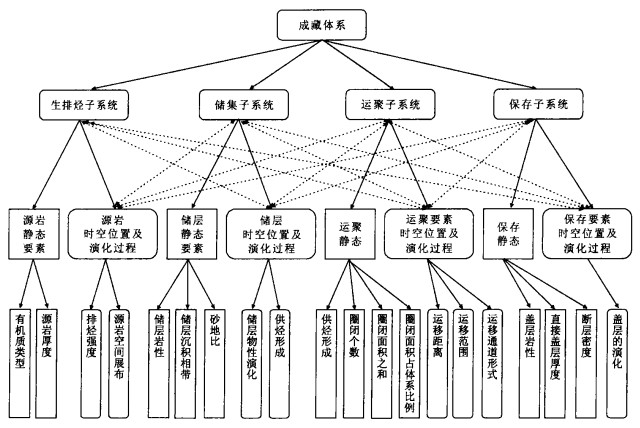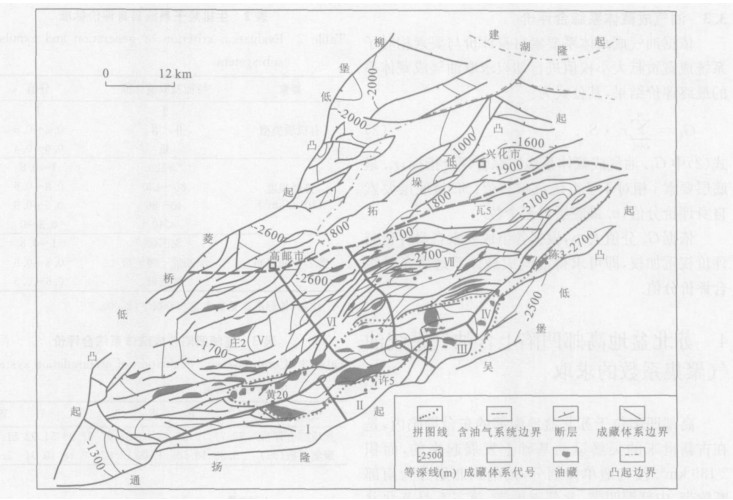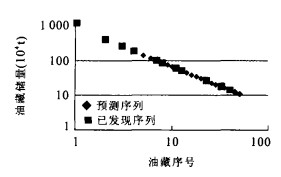Studying Methods and Application of the Hydrocarbon Accumulation Coefficient
-
摘要: 油气聚集系数是油气资源评价中最为关键的一个参数, 影响因素复杂, 如何科学取值一直困扰着石油地质工作者.利用层次分析法建立油气运聚单元(油气成藏体系)定量评价结构模型, 对油气成藏体系进行定量评价; 根据“三高”原则选取刻度区, 利用生烃潜力法和油藏规模序列法求取刻度区的油气聚集系数, 将各油气成藏体系与刻度区类比求取相应油气成藏体系油气聚集系数.运用该方法求取苏北盆地高邮凹陷上含油气系统各油气成藏体系油气聚集系数.结果表明, 高邮凹陷上含油气系统各油气成藏体系油气聚集变化较大, 在9%~14%之间, 用该聚集系数求取的资源量较过去用一个统一的聚集系数求取的资源量更接近地质实际.实践证明, 利用层次分析法定量评价成藏体系, 结合生烃潜力法和油藏规模序列法, 可以对聚集系数进行定量预测, 减少资源量计算中人为因素的影响, 使资源评价更加客观.Abstract: The hydrocarbon accumulation coefficient is a key parameter influenced by many geological factors in the evaluation of hydrocarbon resources and how to attain its value scientifically has always been a big problem. In this paper, the hydrocarbon accumulation system is evaluated quantitatively by the quantitative evaluation model based on the analytical hierarchy process. The calibrated unit is selected according to the three-most principle and its hydrocarbon accumulation coefficient can be calculated by the methods of hydrocarbon-generation potential and pool size serial. The hydrocarbon accumulation coefficient of the intentional system can be gained by the analogy between the referential system and the intentional system. Through the application of the above methods, the hydrocarbon accumulation coefficient of the petroleum accumulation systems in Gaoyou sag of Subei basin can be satisfactorily attained, which proves that the hydrocarbon accumulation coefficient can be achieved quantitatively with the methods of hydrocarbon-generation potential and pool size serial based on the quantitative evaluation of the petroleum accumulation system by the analytical hierarchy process which leads to more objective hydrocarbon resource evaluation by decreasing the subjective factors in the calculation of hydrocarbon amount.
-
表 1 高邮凹陷上含油气系统油气成藏体系划分
Table 1. Division of hydrocarbon accumulation system of upper petroleum system in Gaoyou sag

表 2 生排烃子系统自身评价标准
Table 2. Evaluation criterion of generation and expulsion sub-system

表 3 高邮凹陷各成藏体系综合评价
Table 3. Comprehensive evaluation of accumulation systems in Gaoyou sag

-
Hu, S.Y., Tian, K.Q., Liu, G.D., et al., 2005. Dissection of calibrated units and key parameters for oil and gas resource assessment. Acta Petrolei Sinica, 26(Suppl. ): 49-54(in Chinese with English abstract). Huang, Z.L., Jiang, Z.X., 2000. Reservoir forming mechanism and quantitative evaluation in Turpan-Hami basin. Petroleum Industry Press, Beijing, 124-133(in Chinese). Jia, C.Z., Zhao, Z.Z., Zhao, W.Z., et al., 2005. Petroleum resource and exploration potential of main petroliferous basin onshore in China. Acta Petrolei Sinica, 26(Suppl. ): 1-6(in Chinese with English abstract). Jiang, Z.X., Chen, D.X., Qiu, G.Q., et al., 2003. AHP applied in the research of main controlling factors for studying formation of sand lens reservoir. Petroleum Exploration and Development, 30(3): 44-48(in Chinese with English abstract). Jiang, Z.X., Wang, X.D., Pang, X.Q., et al., 2006. Paleohydrocarbon water contact restoration of typical Silurian oil and gas reservoirs in the northern Tarim basin. Earth Science—Journal of China University of Geosciences, 31(2): 201-208. Jiang, Z.X., Pang, X.Q., Jin, Z.J., et al., 2002. Threshold control over hydrocarbons and its application in distinguishing valid source rock. Earth Science—Journal of China University of Geosciences, 27(6): 689-695(in Chinese with English abstract). Jin, Z.J., Zhang, Y.W., Wang, J., et al., 2003. Hydrocarbon accumulation mechanisms and oil/gas distribution. Petroleum Industry Press, Beijing, 73-79(in Chinese). Liu, G.D., Zhao, W.Z., Hu, S.Y., et al., 2003. Prediction models of migration and accumulation coefficient for petroleum migration and accumulation unit. Petroleum Exploration and Development, 30(5): 53-55(in Chinese with English abstract). Pang, X.Q., Jin, Z.J., Jiang, Z.X., et al., 2002. Quantitative models of hydrocarbon accumulation. Petroleum Industry Press, Beijing, 129-145(in Chinese). Qiao, Y.F., Mao, X.P., Xin, G.Z., 2005. Quantitative simulation of hydrocarbon migration. Earth Science—Journal of China University of Geosciences, 30(5): 617622(in Chinese with English abstract). Shen, P. P., Zhao, W. Z., Dou, L. R., 2000. Oil resource prospects and forecast in the next decade. Acta Petrolei Sinica, 21(4): 1-6(in Chinese with English abstract). Sheng, Z.W., 1989. On the accumulation amount. Petroleum Geology and Experiment, 11(3): 228-233(in Chinese with English abstract). Song, G.Q., 2002. Study and application of the coefficient of hydrocarbon accumulation determined by multifactors. Petroleum Geology and Experiment, 24(2): 168-171 (in Chinese with English abstract). Wang, L.F., Xu, S.B., 1990. Introduction to AHP. Renmin University of China Press, Beijing, 5-18(in Chinese). Wang, T., 2000. The non-replaceable conditions of adopting the strategy of sustainable nation development. In: The 21st Century Chinese Petroleum Strategy Management Session, ed., Chinese natural gas resource strategy in the 21st century selected from the report corpus of Chinese petroleum forum(the second volume). Petroleum Industry Press, Beijing, 5-9(in Chinese). Zhao, H.C., 1986. Analytic hierarchy process. Science Press, Beijing, 1-7(in Chinese). Zhou, J., Pang, X. Q., 2002. A method for calculating the quantity of hydrocarbon generation and expulsion. Petroleum Exploration and Development, 29(1): 24-27 (in Chinese with English abstract). Zhou, S. Y., 1988. Introduction to system science. Seism ological Press, Beijing, 5-18(in Chinese). 胡素云, 田克勤, 柳广弟, 等, 2005. 刻度区解剖方法与油气资源评价关键参数研究. 石油学报, 26(增刊): 49-54. 黄志龙, 姜振学, 2000. 吐哈盆地油气成藏机制与定量评价. 北京: 石油工业出版社, 124-133. 贾承造, 赵政璋, 赵文智, 等, 2005. 陆上主要含油气盆地油气资源与勘探潜力. 石油学报, 26(增刊): 1-6. https://www.cnki.com.cn/Article/CJFDTOTAL-DQKX201903012.htm 姜振学, 陈冬霞, 邱桂强, 等, 2003. 应用层次分析法研究透镜状砂体成藏主控因素. 石油勘探与开发, 30(3): 44-48. doi: 10.3321/j.issn:1000-0747.2003.03.013 姜振学, 庞雄奇, 金之均, 等, 2002. 门限控烃作用及其在有效烃源岩判别研究中的应用. 地球科学——中国地质大学学报, 27(6): 689-695. https://www.cnki.com.cn/Article/CJFDTOTAL-DQKX200206006.htm 姜振学, 王显东, 庞雄奇, 等, 2006. 塔北地区志留系典型油气藏古油水界面恢复. 地球科学——中国地质大学学报, 31(2): 201-208. https://www.cnki.com.cn/Article/CJFDTOTAL-DQKX200602008.htm 金之钧, 张一伟, 王捷, 等, 2003. 油气成藏机理与分布规律. 北京: 石油工业出版社, 73-79. 柳广弟, 赵文智, 胡素云, 等, 2003. 油气运聚单元石油运聚系数的预测模式. 石油勘探与开发, 30(5): 53-55. doi: 10.3321/j.issn:1000-0747.2003.05.015 庞雄奇, 金之均, 姜振学, 等, 2002. 油气成藏定量模式. 北京: 石油工业出版社, 129-145. 乔永富, 毛小平, 辛广柱, 2005. 油气运移聚集定量化模拟. 地球科学——中国地质大学学报, 30(5): 617-622. https://www.cnki.com.cn/Article/CJFDTOTAL-DQKX200505014.htm 沈平平, 赵文智, 窦立荣, 2000. 中国石油资源前景展望及今后10年产量预测. 石油学报, 21(4): 1-6. 盛志伟, 1989. 关于油气聚集量问题. 石油实验地质, 11(3): 228-233. https://www.cnki.com.cn/Article/CJFDTOTAL-SYSD198903002.htm 宋国奇, 2002. 多因素油气聚集系数的研究方法及其应用. 石油实验地质, 24(2): 168-171. doi: 10.3969/j.issn.1001-6112.2002.02.014 王莲芬, 许树柏, 1990. 层次分析法引论. 北京: 中国人民大学出版社, 5-18. 王涛, 2000. 实施国家可持续发展战略不可替代的重要条件. 见: 21世纪中国石油战略高级研讨会编, 21世纪中国天然气资源战略——中国石油论坛报告文集(第2集). 北京: 石油工业出版社, 5-9. 赵焕臣, 1986. 层次分析法. 北京: 科学出版社, 1-7. 周杰, 庞雄奇, 2002. 一种生、排烃计算方法探讨与应用. 石油勘探与开发, 29(1): 24-27. doi: 10.3321/j.issn:1000-0747.2002.01.006 周硕愚, 1988. 系统科学导引. 北京: 地震出版社, 5-18. -










 下载:
下载:




